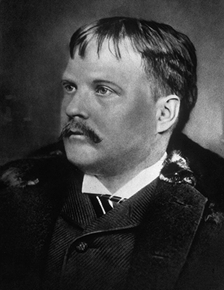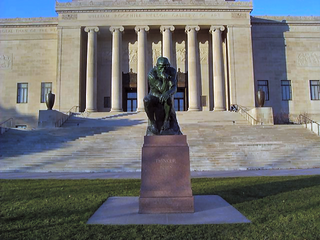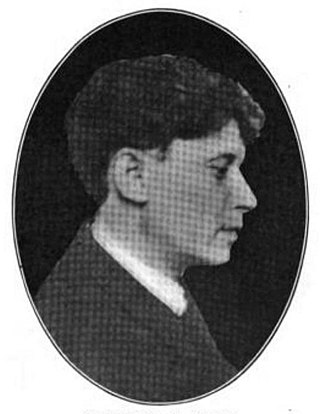
John Wellborn Root was an American architect who was based in Chicago with Daniel Burnham. He was one of the founders of the Chicago School style. Two of his buildings have been designated a National Historic Landmark; others have been designated Chicago landmarks and listed on the National Register of Historic Places. In 1958, he was posthumously awarded the AIA Gold Medal.

William LaBarthe Steele was an American architect from Chicago, Illinois. He is considered a principal member of the Prairie School Architectural Movement during the early 20th century.
Thomas Wilson Williamson was a Kansas architect who specialized in designing school buildings in Kansas, Iowa, and Missouri.

Wight and Wight, known also as Wight & Wight, was an architecture firm in Kansas City, Missouri consisting of the brothers Thomas Wight and William Wight who designed several landmark buildings in Missouri and Kansas.

Louis Singleton Curtiss was a Canadian-born American architect. Notable as a pioneer of the curtain wall design, he was once described as "the Frank Lloyd Wright of Kansas City". In his career, he designed more than 200 buildings, though not all were realized. There are approximately 30 examples of his work still extant in Kansas City, Missouri where Curtiss spent his career, including his best known design, the Boley Clothing Company Building. Other notable works can be found throughout the American midwest.

Frederick F. Faris (1870–1927) was a Wheeling, West Virginia-based architect.

Keene & Simpson was an American architectural firm based in Kansas City, Missouri, and in practice from 1909 until 1980. The named partners were architects Arthur Samuel Keene FAIA (1875–1966) and Leslie Butler Simpson AIA (1885–1961). In 1955 it became Keene & Simpson & Murphy with the addition of John Thomas Murphy FAIA (1913–1999), who managed the firm until his retirement in 1980.

Albert Oscar Clark (1858–1935), commonly known as A.O. Clark, was an American architect who worked in Arkansas in the early 1900s.

William Dubois (1879–1953) was an American architect and politician. He was a prolific architect in Wyoming and nearby states, and served five terms in both houses of the Wyoming Legislature.

Grace Episcopal Cathedral is located in Topeka, Kansas, United States. It is the seat of the Episcopal Diocese of Kansas.

Edmond J. Eckel was an architect in practice in St. Joseph, Missouri, from 1872 until his death in 1934. In 1880 he was the founder of Eckel & Mann, later Eckel & Aldrich and Brunner & Brunner, which was the oldest architectural firm in Missouri prior to its eventual dissolution in 1999.
Edward Alfred Harrison, known as E. A. Harrison, was an American architect who worked as a staff architect for the Atchison, Topeka & Santa Fe Railway, with offices in Topeka, Kansas, and later in Chicago, Illinois.

Harrisonville Courthouse Square Historic District is a national historic district located at Harrisonville, Cass County, Missouri. The district includes 34 contributing buildings, 1 contributing structure, and 1 contributing object in the central business district of Harrisonville. It developed between about 1880 and 1943, and includes representative examples of Italianate, Queen Anne, Colonial Revival, Tudor Revival, and Renaissance Revival style architecture. Notable buildings include the Cass County Courthouse (1897), New Method Laundry (1929), Cass County Democrat, Wooldridge Building, Bank of Harrisonville (1900-1901), Wirt's Opera House Building, Post Office Building (1925), Emmons Building/Bowman Building (1887), Evans Building (1890), White Motor Company, Stephen Stuart "Racket" Store, First National Bank of Harrisonville, and Deacon Building (1892).
Charles D. Cuthbert was an architect in the U.S. state of Kansas. Several of his works are listed on the National Register of Historic Places.

Frank C. Squires (1871–1934) was an American architect based in Topeka, Kansas. A number of his works are listed on the National Register of Historic Places.

The Scarritt Building and Arcade is a historic building in Kansas City, Missouri. It was built in 1906. It was designed by Root & Siemens. It has been listed on the National Register of Historic Places since March 9, 1971.
Frederick C. Gunn was an American architect. In the firm of Gunn & Curtiss with Louis Singleton Curtiss he helped design several county courthouses.
George E. McDonald was an architect in the United States. He is credited with designing several courthouses listed on the National Register of Historic Places:

Alfred Clas was an architect in Milwaukee, Wisconsin. He was a partner in the firm Ferry & Clas with George Bowman Ferry and in 1913 Alfred C. Clas partnered with his son Reuben F. Clas and with John S. Shepherd, as junior partners, to form the firm of Clas, Shepherd & Clas. Shepherd withdrew in 1931 and the firm became Clas & Clas, Inc., with Alfred Clas remaining president until his death in 1942.
Harry A. Overbeck (1861–1942) was an American architect. He was active in Omaha, Nebraska and then for most of his career in Dallas, Texas. He designed several prominent buildings including a Mississippi Landmark and properties on the National Register of Historic Places.

















